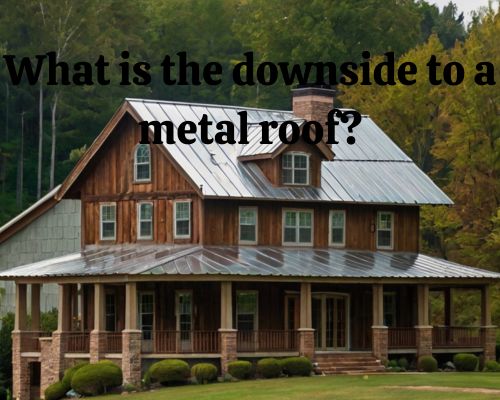
An In-Depth Look
What is the downside to a metal roof? Let us get to know it with Star Roofing Contractors.

When considering a metal roof for your home, one significant downside is the upfront cost.
Metal roofs are considerably more expensive than traditional asphalt shingles, often costing twice as much.
This higher initial investment can be a major deterrent for homeowners working within a strict budget.
Another potential drawback is the noise factor.
During heavy rain or hailstorms, metal roofs can be noisier compared to other types of roofing materials.
While some find the sound of rain soothing, others may find it disruptive.
Insulation can help mitigate this issue, but it’s an added expense to consider.
Rust and corrosion are also concerns, especially in coastal areas where salt in the air can accelerate metal deterioration.
Although modern metal roofing usually comes with protective coatings, these can wear off over time.
Regular maintenance is required to ensure longevity and durability, making it an ongoing investment for any homeowner.
Initial Investment and Cost Considerations
When considering a metal roof, the initial investment and cost factors are crucial.
Based on Star Roofing Contractors, a metal roof may have higher upfront costs compared to other materials, but its long lifespan and energy efficiency can offer substantial long-term savings and value.
Comparing Metal to Asphalt and Other Materials
Metal roofs often come with a higher initial cost compared to materials like asphalt shingles.
The cost per 100 square feet can range from $120 to $900, depending on the type of metal (e.g., steel, aluminum, copper, or tin).
In contrast, asphalt shingles typically cost less, making them a popular choice for many homeowners. However, asphalt roofs generally require more frequent replacements, approximately every 12-25 years.
Other roofing materials like slate and tile also have their own cost profiles.
Although these materials are durable, they can be more expensive and heavier, potentially requiring additional structural support.
Metal roofs, being lighter, usually don’t need such reinforcements.
Long-Term Savings and Value
Despite the higher initial expense, a metal roof can be a cost-effective investment.
Metal roofs are highly long-lasting, with a lifespan of 40-70 years. This reduces the likelihood of frequent roof replacements, saving you money over time.
Additionally, metal roofs are energy-efficient, reflecting solar heat and reducing cooling costs by 10-25%.
Maintenance is another area where metal roofs shine.
They tend to have lower maintenance requirements compared to asphalt shingles, which can deteriorate faster due to weather conditions.
Furthermore, many metal roofs come with extensive warranties that offer added peace of mind.
Moreover, investing in a metal roof can lead to insurance discounts, as its durability makes it less prone to damage.
Additionally, metal is often made from recycled materials, making it an environmentally friendly option.
Performance and Durability Challenges
Metal roofing offers several advantages, but it also presents some performance and durability challenges specific to weather-related concerns and installation and maintenance factors.
Weather-Related Concerns
Metal roofs, while durable, can be susceptible to extreme weather.
Hail and debris can cause dents and damage, especially on softer metals like aluminum.
Hailstorms can leave noticeable marks, affecting both performance and curb appeal.
Steel roofing is more resistant to dents, but not immune.
Snow and ice can lead to ice dams, potentially causing leaks if not managed properly.
Extreme weather such as heavy rain and lightning strikes can also pose risks.
Although metal roofs are fire-retardant, they can be noisy during rain or hail unless installed with proper insulation or solid sheathing.
Installation and Maintenance Factors
Installation of metal roofs requires expertise. Improperly installed fasteners can lead to leaks and reduced performance.
The choice of materials impacts durability and resistance to rust and corrosion. For example, galvanized steel and zinc finishes are popular options.
Maintaining a metal roof involves regular inspections, especially after severe weather. Though generally low maintenance, any corrosion or damage should be promptly addressed to ensure longevity.
Adding solar panels can complicate maintenance, requiring careful planning.
Finally, while metal roofs are 100% recyclable, they must be properly maintained to avoid premature wear and tear. This includes ensuring that all materials and finishes are up to standard to prevent deterioration over time.





